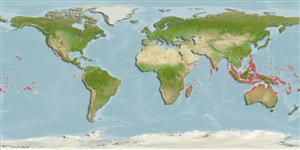Common names from other countries
Environment: milieu / climate zone / depth range / distribution range
Ecología
marino; salobre asociado a arrecife; rango de profundidad 0 - 3 m (Ref. 86942). Tropical; 25°N - 24°S
Indo-Pacific: East Africa to the Marquesan and Tuamoto islands, north to the Yaeyamas. At least one country reports adverse ecological impact after introduction.
Tamaño / Peso / Age
Maturity: Lm ? range ? - ? cm
Max length : 47.7 cm FL macho / no sexado; (Ref. 107958); common length : 25.0 cm TL macho / no sexado; (Ref. 2871)
Espinas dorsales (total) : 4; Radios blandos dorsales (total) : 9 - 10; Espinas anales: 3; Radios blandos anales: 8 - 9. Olive dorsally; flanks and abdomen silvery; fins hyaline (Ref. 9812). Pectoral fins with dark spot dorsally at origin (Ref. 9812).
Inhabit shallow protected sandy to muddy areas of reef flats and shallow lagoons while juveniles have been encountered in tide pools (Ref. 205). Benthopelagic (Ref. 58302). Oviparous, eggs are pelagic and non-adhesive (Ref. 205). Marketed fresh and used as live bait in pole-and-line fishing for tuna (Ref. 9812).
Life cycle and mating behavior
Maturities | Reproducción | Spawnings | Egg(s) | Fecundities | Larva
Myers, R.F., 1991. Micronesian reef fishes. Second Ed. Coral Graphics, Barrigada, Guam. 298 p. (Ref. 1602)
IUCN Red List Status (Ref. 130435)
CITES (Ref. 128078)
Not Evaluated
Threat to humans
Potential pest (Ref. 6362)
Human uses
Pesquerías: comercial; carnada: occasionally
Herramientas
Special reports
Download XML
Fuentes de Internet
Estimates based on models
Preferred temperature (Ref.
115969): 25.4 - 29.3, mean 28.5 (based on 2596 cells).
Phylogenetic diversity index (Ref.
82804): PD
50 = 0.5625 [Uniqueness, from 0.5 = low to 2.0 = high].
Bayesian length-weight: a=0.01175 (0.01021 - 0.01353), b=2.96 (2.92 - 3.00), in cm Total Length, based on LWR estimates for this species (Ref.
93245).
Resiliencia (Ref.
120179): Medio, población duplicada en un tiempo mínimo de 1.4-4.4 años (Preliminary K or Fecundity.).
Fishing Vulnerability (Ref.
59153): Moderate vulnerability (41 of 100).
